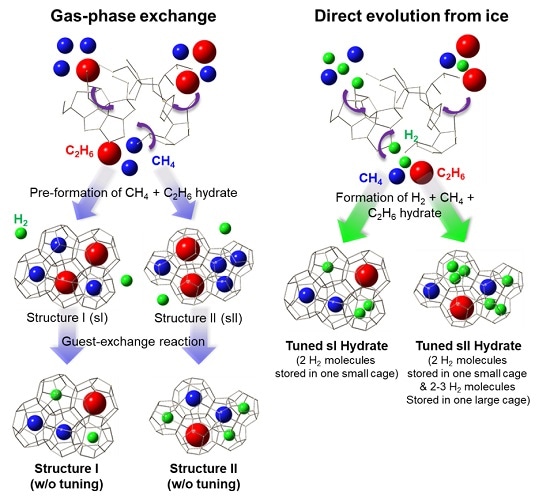Jun 24 2019
A hydrogen-natural gas blend (HNGB) can become a revolutionary concept only if it is stored safely and utilized as a sustainable clean energy resource. A recently conducted study has proposed a new strategy for stably storing hydrogen, with the help of natural gas as a stabilizer. The research suggested a practical gas phase modulator-based synthesis of HNGB without producing chemical waste after dissociation for instant service.
 Schematics showing the storage method for hydrogen in a natural gas hydrate using a substitution method and storage method directly from ice to a hydrogen-natural gas hydrate. (Image credit: KAIST)
Schematics showing the storage method for hydrogen in a natural gas hydrate using a substitution method and storage method directly from ice to a hydrogen-natural gas hydrate. (Image credit: KAIST)
The research team of Professor Jae Woo Lee from the Department of Chemical and Biomolecular Engineering in partnership with the Gwangju Institute of Science and Technology (GIST) showed that the natural gas modulator-based synthesis results in considerably reduced synthesis pressure concurrently with the creation of hydrogen clusters in the confined nanoporous cages of clathrate hydrates. This method reduces the impact on the environment and minimizes operation costs as clathrate hydrates do not produce any chemical waste in the synthesis as well as decomposition processes.
For efficient hydrogen storage and transportation, several materials have been explored. Among others, clathrate hydrates provide unique benefits. Clathrate hydrates are nanoporous inclusion compounds made up of a 3D network of polyhedral cages composed of hydrogen-bonded “host” water molecules and captured “guest” liquid or gas molecules.
For the study, the researchers used two gases, ethane and methane, which contain lower equilibrium conditions compared to hydrogen as thermodynamic stabilizers. Consequently, they were successful in stably storing the hydrogen-natural gas compound in hydrates.
In line with the composition ratio of methane and ethane, structure I or II hydrates can be developed, both of which can stably store hydrogen-natural gas in low-pressure settings.
The team learned that two hydrogen molecules are stored in small cages in tuned structure I hydrates, while up to three hydrogen molecules can be stored in both large and small cages in tuned structure II hydrates. Hydrates can store gas up to about 170-times its volume and the natural gas used as thermodynamic stabilizers in this research can also be employed as an energy source.
The researchers created a technology to make hydrates from ice, made hydrogen-natural gas hydrates by substitution, and successfully observed that the tuning occurrence only happens when hydrogen is involved in hydrate formation from the beginning for both structures of hydrates.
They anticipate that the findings can be used not only as an energy-efficient gas storage material, but also a smart platform to utilize HNGBs, which can act as a new substitute energy source with targeted hydrogen contents by engineering synthetic pathways of mixed gas hydrates.
The research was reported online in Energy Storage Materials on June 6th, under the title “One-step formation of hydrogen clusters in clathrate hydrates stabilized via natural gas blending”.
HNGB will utilize the existing natural gas infrastructure for transportation, so it is very likely that we can commercialize this hydrate system. We are investigating the kinetic performance through a follow-up strategy to increase the volume of gas storage.
Professor Jae Woo Lee, Department of Chemical and Biomolecular Engineering, KAIST
This research was sponsored by the National Research Foundation of Korea and BK21 plus program.